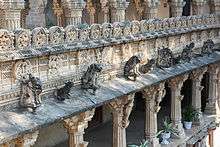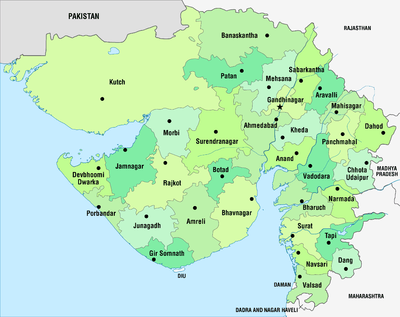Gondal, India
| Gondal | |
|---|---|
| City | |
|
View of Gondal | |
 Gondal  Gondal Location in Gujarat, India | |
| Coordinates: 21°57′29″N 70°47′42″E / 21.958°N 70.795°ECoordinates: 21°57′29″N 70°47′42″E / 21.958°N 70.795°E | |
| Country |
|
| State | Gujarat |
| District | Rajkot |
| Elevation | 132 m (433 ft) |
| Population (2011) | |
| • Total | 1,12,064 |
| Languages | |
| • Official | Gujarati, Hindi |
| Time zone | IST (UTC+5:30) |
| Vehicle registration | GJ |
| Website | www.gondalonline.com |
Gondal is a city and a municipality in the Rajkot district of the Indian state of Gujarat. Gondal state was one of the eight first class princely states of Kathiawar Agency, Bombay Presidency in British India. Ruled by a Hindu Rajput dynasty of the Jadeja clan, the capital of the state was Gondal town. In 2011, the Population of the Gondal City Was 113,000 approximately.[1]
History

Gondal is mentioned in texts like Ain-i-Akbari (written in the reign of Akbar) and Mirat-i-Ahmadi as a Vaghela state in Sorath (Saurashtra). The Gondal state in Kathiawar Agency was founded in 1634 by Thakore Shri Kumbhoji I Meramanji from the Jadeja dynasty, who received Ardoi and other villages from his father Meramanji.[2][3] Kumbhoki's fourth descendant, Kumbhoji IV, increased the size of the state by acquiring parganas such as Doraji, Upleta, and Sarai.[2]
Sir Bhagwant Singhji, who reigned from 1888 until his death in 1944, was noted for tax reforms, compulsory education for women, and also for stopping the practice of purdah (female seclusion) at a time when the royal households of India were known for this tradition.[4]
In 1901, Gondal city had a population of 19,592, and was a stop on the branch line between Rajkot and Jetalsar on the Viramgam-Rajkot and Rajkot-Somnath lines.[5]
The acestors of Muhammad Ali Jinnah, founder of Pakistan, belong to Paneli village in Gondal state.
Historical places of Gondal


The Naulakha Palace is the oldest extant palace in Gondal, dating back to the 17th century.[6][7] It has stone carvings with jharokhas (enclosed balconies), a pillared courtyard, delicately carved arches, and a unique spiral staircase. The large chandelier-lit durbar (court) contains stuffed panthers, gilt wooden furniture, and antique mirrors. The Private Palace Museum has a display of silver caskets which were used to carry messages and gifts for Maharajah Bhagwat Sinhji during his silver jubilee as ruler of Gondal.
The Riverside Palace was built in 1875 by Maharajah Bhagwat Sinhji for his son, Yuvraj Bhojraji. It has groomed lawns and gardens, a living room furnished in typical colonial style with chandelier, antique wooden furniture and sofas, and an "Indian room" decorated with beadwork, brassware and paintings. The palace has now become a heritage hotel.[8][9]
The Huzoor Palace is the current royal residence. One wing of this palace, called the Orchard palace, is open to the public. It was built as an annex of the Huzoor Palace in the late 19th century to host guests of the Maharajas. The property gets its name from the fruit orchards, lawns and gardens that surround the palace.[10]
Orchard Palace was converted into a seven-room heritage hotel decorated with 1930s–1940s art deco furniture, antiques and handicrafts. The garden contains many types of birds, including a large population of peacocks. The Room of Miniatures is a sitting room with a collection of miniature paintings, brass, and furniture. One of the highlights of the palace is the Rail Saloon of the royal family of Gondal which has been converted into a suite with a drawing room, dining room and bedroom. The royal garages have an extensive collection of vintage and classic cars.[11]
Thakurs
The rulers of Gondal were Thakurs of the Jadeja dynasty who had the right to an 11 gun salute. They bore the title 'Thakur Sahib' from 1866 onwards.
| Tenure | Name (birth-death) |
|---|---|
| 1648 - 1713 | Sagramji I Kumbhoji (b. 1634 - d. 1713) |
| 1713 - 1752 | Haloji Sagramji (b. 1676 - d. 1752) |
| 1752 - 1789 | Kumbhoji II Haloji (b. 1712 - d. 1789) |
| 1789 - 1791 | Muluji Sagramji (Malubhai Sahib) (b. 1754 - d. 1791) |
| 1791 - 1800 | Dajibhai Muluji (b. 1775 - d. 1800) |
| 1800 - 1812 | Devaji Sagramji (Devabhai Sahib) (b. 1769 - d. 1812) |
| 1812 - 1814 | Nathuji Devaji (Nathubhai Sahib) (d. 1814) |
| 1814 - 1821 | Kanuji Devaji (b. ... - d. 1821) |
| 1821 - 1841 | Chandrasimhji Devaji (Motibhai Sahib) (b. 1797 - d. 1841) |
| 1841 - 1851 | Bhanabhai Devaji (d. 1851) |
| 1851 - 1866 | Sagramji II Devaji (Sagramji Bhanabhai) (b. 1822 - d. 1869) |
| 1866 - 14 Dec 1869 | Sagramji II Devaji (s.a.) |
| 14 Dec 1869 - 10 Mar 1944 | Bhagwatsimhji Sagramsimhji (b. 1865 - d. 1944)
(from 15 Feb 1887, Sir Bhagwatsimhji Sagramsimhji) (personal style Maharaja from 1 Jan 1888) |
| 10 Mar 1944 - 15 Aug 1947 | Bhojrajji Bhagwatsimhji (b. 1883 - d. 1952)
(personal style Maharaja) |
Religious sites
.jpg)
The people of the Gondal, as in most of the other parts of Saurashtra, are considered highly spiritual. The temples in Gondal include Akshar Mandir (BAPS Swaminarayan), Shri Trikamrayji Haveli, Bhuvneshwari Mandir (one of the few temples in India dedicated to this Goddess, Ashapura Mata, Sureshwar Mahadev, Dhareshwar Mahadev and Ambey Dham (Ramanath) Temple.
The Akshar Deri, housed within the Akshar Mandir, is the samadhi sthan (memorial site) of Gunatitanand Swami, who was a paramhansa of Swaminarayan, and is accepted as the first spiritual successor of Swaminarayan by the Bochasanwasi Akshar Purushottam Swaminarayan Sanstha (BAPS).[12] This temple is visited by people from all over the world
Dasi Jeevan Mandir (temple) in Ghoghavadar, 6 km (3.7 mi) from Gondal, is a site where Saint Dasi Jeevan lived.[13] Every Gujarati New Year day, people gather to celebrate the holy saint's birthday.
Anand Ashrama, located in Gondal, is a research centre for folklore and Gujarati literature.[14]
Geography
Gondal is located at 21°58′N 70°48′E / 21.97°N 70.8°E.[15] It has an average elevation of 132 metres (433 feet).
Demographics
Total Population of Gondal City as per last census was 113,000 Approx. while the Average Literacy rate is 84.3% much higher than the national average of 59% . The Demographic Distribution of the Gondal city as per 2011 census is as mentioned below :
| Particulars | Total | Males | Females |
|---|---|---|---|
| City Population | 112,197 | 58,300 | 53,897 |
| Literates | 84,394 | 45,853 | 38,541 |
| Children (0-6) | 12,037 | 6,548 | 5,489 |
| Avg Literacy | 84.26 % | 88.60 % | 79.62 % |
| Sexratio | 924 |
Culture and economy
Gondal has a history of art and literature. It is the birthplace of poets, singers and artists like Pankaj Udhas, Manhar Udhas, Nirmal Udhas, Dhumaketu, Makarand Dave, Jay Vasavada, Sairam Dave, Vipul Mangukiya and Atul Pandya.[16][17] The first Gujarati dictionary was written by noted educationalists/authors (like Shri Champaklal Vyas) in Gondal with the financial support of Sir Bhagvatsighji Maharaj.
The largest factors in the economy of Gondal are oil mills and marketing yards. Gondal is the largest producer of ground nut oil in Gujarat, with 300–500 oil mills. The marketing yard is one of the biggest in the Kathiawar region and the second largest in Gujarat, after Unjha. Gondal is growing in the cotton trade with the development of many ginning and pressing industries.
In addition, there are two Ayurvedic (alternative) medicine manufacturers in Gondal that export overseas, as well as businesses involved in jewelry design, timber trading, and hardware manufacturing. Farming is important in the outskirts of Gondal despite a shortage of water. The markets for most commodities in Gondal are in two areas known as Nani Bazaar (small market) and Moti Bazaar (large market). The main business areas in Gondal include Town Hall, Gundala Street, Nani Bazaar, Moti Bazaar, Kadiyalane, Bus stand road, and Kumbharwada.
Transportation from other parts of the country is primarily by road and rail. Gondal railway station, under the Bhavnagar railway division, serves Gondal city.
The main residential areas in Gondal include G. Parekh Street, Chunara Street, Khandheria Street, Gundala Street, Mahadevwadi, Bhojarajapara, Housing Board, Station Plot, Gundala Road, Yoginagar, Shajanand Nagar, Khodiyar Nagar and Gokul Dham. The most upscale residential areas in Gondal are Kailashbag and Radha-Krishna Nagar, which are near to the bus station and the main market. Gardens and parks include Tulsi Baugh and Ashapura Gardens.
The schools in Gondal include St. Mary's School, Vidhya mandir, Patel Boarding, Akshar Purshotam Swami Narayan High School, and Highway Gurukul. Monghiba High school is one of the oldest girls' schools in the region.
Other landmarks in Gondal are the Center Theater, the Roma Theater, College Chowk, and the Victory Cinema.
In 1947, many people who spoke Memoni migrated to Pakistan. Dr. Abdul Ghaffar Javeri was a doctor who migrated to Karachi-Pakistan; his clinic was at Achi Qabar, beside the Boulton Market.
Devchadi is a village near Gondal that was founded in 1960.
See also
References
- ↑ "Census of India: 2011". Census Commission of India. Retrieved 2016-07-03.
- 1 2 Gondal state The Imperial Gazetteer of India, 1908. v. 12, p. 319
- ↑ Princely Gondal RoyalArk
- ↑ Purdah Women TIME, Monday, November 24, 1930.
- ↑ Gondal Town The Imperial Gazetteer of India, 1908, v. 12, p. 321
- ↑ "Gondal, City State, Rajkot, Tourism Hubs, Gujarat, India". Gujarattourism.com. Retrieved 12 June 2016.
- ↑ "Navlakha Palace Gondal". discoveredindia.com. Retrieved 12 June 2016.
- ↑ Heritage Hotels in Gujarat
- ↑ "History of Gondal". Heritagepalacesgondal.com. Retrieved June 12, 2016.
- ↑ "Orchard Palace". Heritagepalacesgondal.com. Retrieved June 12, 2016.
- ↑ Hot wheels: Vintage cars from Gondal to elegantly parade in Mumbai Indian Express, September 10, 2008.
- ↑ Waghorne, Joanne (1985). Gods Of Flesh. Gods Of Stone. United States: Columbia University Press. p. 147. ISBN 978-0-231-10777-8.
- ↑ "દાસી જીવણ, Dasi Jivan". sureshbjani.wordpress.com. Retrieved June 12, 2016.
- ↑ "Anand Ashram, Ghoghavadar". Anand-ashram.com. Retrieved June 12, 2016.
- ↑ Falling Rain Genomics, Inc - Gondal
- ↑ "Kathiyawad Airlines - Sairam Dave - Gujarati Jokes". Gujaratishow.com. Retrieved June 12, 2016.
- ↑ "Archived copy". Archived from the original on July 14, 2014. Retrieved July 6, 2014.
| Wikisource has the text of the 1911 Encyclopædia Britannica article Gondal. |
- Harikrishna Laishankar Dave (1867). A Short History of Gondal. Education Society's Press. p. 202.
External links
| Wikimedia Commons has media related to Gondal, India. |
- History and all information of Gondal http://www.marugondal.com
- Portal of Gondal Business www.gondalonline.com
- Portal of Gondal Heritage Palaces www.heritagepalacesgondal.com

